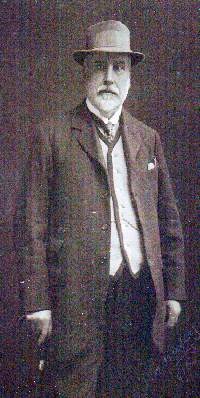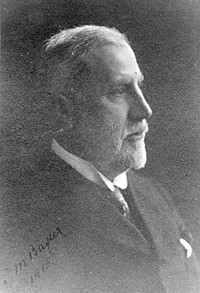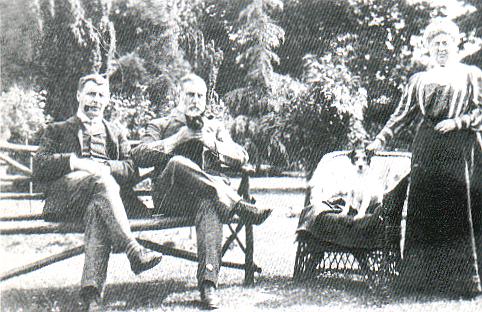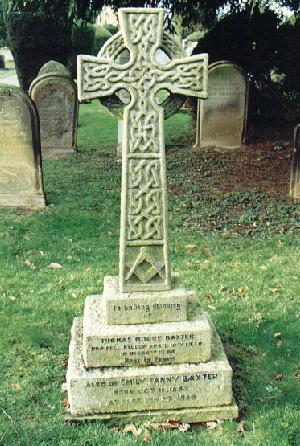|

|
Thomas
Moore
Baxter
1854-1920
|
The young assistant engaged by Robert Mason Mills to run his chemist's shop at No 1 West Street in 1878 was destined to become one of the town's most prominent citizens during the next 40 years. He was Thomas Moore Baxter who married
his employer's only daughter Emily. He later became
a partner in the business and
eventually took over the company when Robert Mills died in 1904.
Thomas Baxter was born at Wisbech, Cambridgeshire, on 15th August 1854, the second son of a successful wine merchant, chemist and ship owner who had been engaged on the transportation of forage during the
Crimean War of 1853-56. He too became a chemist and after qualifying in his profession, left home to join a relation in the management of a business at Brighton. He met Emily Mills and they became engaged and at the age of 24, moved to Bourne where he began a successful career, firstly managing the shop and then the aerated water business that
Robert Mills had started in 1864. It was mainly due to his business acumen and enterprising methods that the firm
R M Mills and Co flourished and soon ranked as one of the biggest companies of its kind in Lincolnshire.
His interests also extended to agriculture which brought him into contact with many farmers in the locality and he became a frequent prize-winner at agricultural shows. He also made his mark in community affairs, becoming a member of the parish council in Bourne when it was established under the Local Government Act of 1894 and then of Bourne Urban District Council when it was formed in April 1899,
sitting on most of the principal committees and serving as chairman of housing and
gas. Fen drainage was also a matter of importance to him and he was for many years a member of the South Fen Drainage Trust.
|
 |
The official photograph of Councillor T M Baxter J P
which was taken when he was chairman of Bourne Urban District Council in
1915-16 and hung in the council chamber with other official portraits of
past council chairmen. |
In the years that followed, Baxter became associated with many of the town's organisations, official, social, and sporting, serving as a Justice of the Peace, a charity trustee, an Overseer of the Poor, a director of the gas and waterworks companies, vice-president of the Tradesmen's Association and an executive committee member of the Bourne Institute. Like his father-in-law before him, he was also agent to the Marquis of Exeter who was Lord of the Manor of Bourne and he also acted on behalf of Lord Kesteven in distributing benefits to tenants of the Trollope bedehouses in South Street (now the Tudor almshouses).
For many years, he also took an active interest in secondary education and in 1910, tried to revive the old grammar school which
had then been disused since 1903. He wrote to Lord Kesteven: "The old school wants a little attention, the roof is not rainproof, and the mischievous young Bournites have broken a good many panes of glass in the windows." His appeal was unsuccessful but in 1918 he renewed his attempts to introduce secondary education in Bourne and the public debate that ensued led to the opening of a secondary school in North Street, Bourne, in September 1920, although he did not live to see it.
|
 |
|
Thomas Moore Baxter and his family lived for a time at Beaufort House, a large red brick Victorian property at No
30 West Street, but later moved to
the late 18th century Saxonhurst House at No 35, on the other side of
West Street. He is pictured here in the garden, holding the
family's pet cat, with his wife Emily and their son Cyril Harry Mills Baxter
(on the left) and their pet dog sitting in a chair. |
Mr Baxter was also an advocate of improved facilities for public health and, together with Alderman William Wherry, helped in the formation of the Bourne Nursing Association in 1899, subsequently serving as its treasurer, and when the Butterfield Hospital opened in 1910 he became a trustee, a post he held until his death. Like his father in law,
he was a staunch churchman and became vicar's warden at the Abbey Church in 1893, serving three incumbents for the next 27 years and from 1892, he also acted as treasurer for the various restoration funds associated with the building. He was 60 when the First World War began in 1914 and was therefore ineligible for military service but served on the home front as a member of the Bourne Urban Military Tribunal, vice-chairman of the Kesteven Appeal Tribunal and a member of the Bourne Urban Food Control Committee.
His political beliefs were Conservative and few meetings took place at the Corn Exchange without his presence on the platform. He was also untiring in his work on behalf of the Primrose League, the organisation instituted in 1883 by Lord Randolph Churchill and others that was devoted to the spreading of Conservative principles such as the maintenance of religion, the estates of the realm and Great Britain's imperial ascendancy, serving as a deputy ruling councillor. He was also a founder member of the Bourne branch of the National Conservative League, later being appointed its Deputy Grand Master. He became chairman of the urban district council in 1915-16 and the same year served as Worshipful Master of the Hereward Lodge of Freemasons.
Thomas Baxter was particularly fond of angling, both as a participant and as an administrator, becoming president of the Bourne Angling Association and an enthusiastic presence at their monthly meetings. He subsequently purchased the fishing rights for the parish of Bourne along the Bourne Eau and River Glen for the club's use that were passed on to his son Cyril after his death. See
The Bourne Eau
|
In his final years,
he suffered from heart trouble and never fully recovered from a seizure while on his way home from a council committee meeting early in February 1920. Doctors advised him to give up all public appointments but his health continued to deteriorate and after being confined to his bed for ten weeks, he died on Saturday 10th April at the age of 65. His wife Emily survived him until she died on 27th February 1939, aged
83, and they are buried together in the town cemetery in a grave next to her parents, Robert Mason and Fanny Mills. |
 |
The vicar, Canon John Grinter,
paid a handsome tribute to his warden on receiving his letter of resignation the
evening before his death: "I can never thank you for all the care, thought,
labour and money which you and your family have so generously bestowed on the
church and I know the beautiful old abbey is very dear to you. It has been one of the happiest experiences of my ministry to work with a layman who so thoroughly has the church and its welfare at heart and I regret beyond measure that the time has been so short. The reverence, dignity and business-like manner in which you have always discharged your duties have been most marked and your grand example will live long in the memories of church people at Bourne."
The Lincolnshire Free Press was even more fulsome in its praise of a man who had become a pillar of the community during three decades of public service. His extensive obituary, published on 13th April 1920, said:
It is with unfeigned regret that we chronicle his
passing. In a nutshell, his life was one of indomitable perseverance. Success
characterised his whole business career. His diurnal occupations would have been
more than sufficient for most businessmen but his was another instance of the
busy man making time to do what he could for the benefit of fellow townsmen. His
business capacity fitted him for public work and the town owes a debt of
gratitude to him for his long and excellent services. He was a man who also
commanded a good knowledge of language and was thoroughly versed in all public
matters. Whether a matter was popular or not, Mr Baxter always spoke his mind.
He never put his conscience in his pocket for the sake of popularity but he
aired his views whether supported or not. One calls to mind a bombshell he threw
at a charity inquiry some years ago when he made a startling indictment
concerning the distribution of charities and during his public career he had
several times been a central figure in argumentative debates. Although
implacable in his views, he would never descend to upbraid an opponent and
though the strongest of party men, he would never allow his political feelings
to enter any argument where there might be a disturbing element in any of his
other spheres of life. It is no mere platitude to state that Mr Baxter will be a
much missed man.
The funeral took place at the Abbey Church on Tuesday 13th April, conducted by Canon Grinter assisted by the curate, the Rev C M Sharpe, and was followed by interment at the town cemetery. The church was full of friends, family and sympathisers and representatives of the various organisations with which he had been connected during his lifetime. A memorial service was held in Bourne Abbey the
following Sunday, preceded by a muffled peal of the bells. The vicar referred to Baxter's long association with the church and added: "The scarcity of such men has made their places all the more difficult to fill and I appeal to the younger generation to play their part in the work hitherto carried on by men like Thomas Moore Baxter."
In his will, Thomas bequeathed £200 to the Butterfield Hospital and one of the beds in the new wards then being planned for the 1921 extension was named after him. A more curious legacy was that of £100 (about £3,000 at today's spending value) to the Abbey Church with the request that a Jacobean oak pulpit be provided to replace that currently in use. This particular bequest refers to the incongruous stone pulpit that was installed in 1890 to replace its oak Jacobean predecessor that had been sold off to the parish of Frampton, near Boston, Lincolnshire, for three guineas in the belief that a Norman church should have a Norman pulpit. It was later discovered that this supposition was incorrect and that such churches had no pulpit. Baxter must have looked at this anachronism with some annoyance during his 27 years as vicar's warden and may have been trying to remedy the travesty but although the money was received and the church architects, Traylen and Lenton of Stamford, instructed to provide a probable cost for the project, his wishes were not carried out because the stone pulpit remains intact.
Instead, the £100 was used to help finance a Lady Chapel in the church and the balance was met by his widow, Mrs
Emily Baxter "as a gift of love and gratitude". It was installed the following year and the
Stamford Mercury reported on Friday 15th April 1921:
|
GENEROUS GIFT TO ABBEY CHURCH
The gift is a magnificent one, the altar being 5ft. 9in. in deeply-carved oak, with three panels, richly gilded and coloured in blue and red. The centre panel shows the chalice and sacred monogram, and the side panels the vine and grapes etc. The cross is 20 inches and the candlesticks 17½ inches, of silver bronze, the floreat head of the cross being of blue and green enamel. The centre panel is of blue enamel, made by the Dray Metal Works, Leicester, from Mr Traylen's (Stamford) design. The dossel is of Madonna blue brocaded silk, the orphreys of dark blue plush, edged with gold braid, and the vases are of deeply-cut antique glass. The credence bracket is of carved oak, gilded and
coloured. The piscina has been renewed and removed. The super-frontal is of handsome point lace, made and given by Misses Caulton of Bourne, who have also provided the chalice veil with deep border of point lace.
The architect was Mr Traylen (Messrs. Traylen and Lenton, Stamford), the altar etc have been carved by Messrs. Bowman and Son (Stamford) and the dossel made by Miss Erskine
(Stamford), all from Mr Traylen's designs. The stone work and all necessary decoration has been carried out by Mr John Wright.
A small bronze memorial tablet is fixed on the wall bearing the inscription:-"To the honour and glory of God, and in loving memory of Thomas Moore Baxter, 27 years Churchwarden of this Church. Born August 15th, 1854, at rest, April 10th, 1920."
A special celebration of the holy communion was held on Sunday morning when the Lady Chapel was dedicated. At the morning service, special reference was made by the vicar to the munificent gift. Referring to it as a memorial, the vicar remarked how many of them during the past year had wished that Mr Baxter were present to give them the advantage of his opinion, not only in connection with the church but also with the business life of the town. |
See also
Robert
Mason Mills Mrs Pat
Edmunds
The aerated water industry
The Abbey Church

Go to:
Main Index Villages
Index
|



